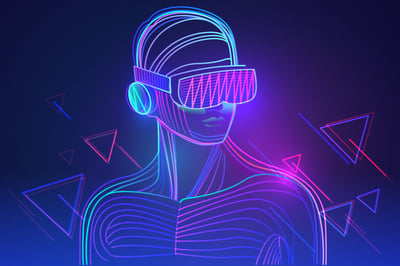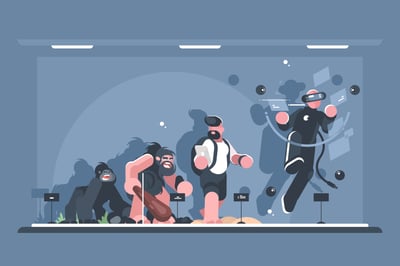October 29, 2020
 by Slava Podmurnyi / October 29, 2020
by Slava Podmurnyi / October 29, 2020

From time to time, every business goes through ups and downs.
At certain times, unforeseen circumstances from the outside, forces businesses to adapt immediately or suffer the consequences.
Each company needs to battle their own challenges. To stay afloat everyone should keep pace with the newest trends and implement the best business practices. Adding to the already known digitalization, interactivity goes far ahead in the desire of business owners to satisfy demanding customers.
This article will help you to understand how interactive business wins the hearts of consumers and lays the foundation for dominance on the market.
An interactive business is a cutting-edge approach to doing business differently. It is a business shift that moves with the times. As things change externally, so do internal movements within your business regarding technology and processes.
Besides usual competition on the market, the world has suffered from unusual circumstances that have resulted in economic decline.
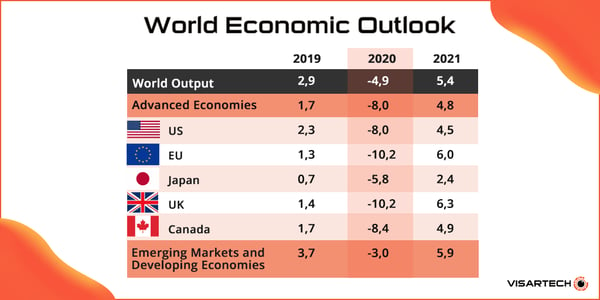
According to the International Monetary Fund, Gross domestic product is estimated to decrease like never before. US's GDP gets 8% drop, Japan - 6%, UK - 10% and the EU zone on average - 10%.
It's not an easy task to survive any fall, but who survives will feel the growth afterward. And the predictions for 2021 prove it. This whole situation has changed people's lives, but not every business is able to adapt to such changes.
The entire picture is both pessimistic and optimistic; there is growth and failure. Every business has an adaptation challenge related to the surrounding at the given time. Now, the biggest business challenge is digitalization.
The world goes digital. It is simply a safer environment, where all can communicate and collaborate, no matter what waits for us outside. Entities that will find the right collaboration tools with customers and employees will enjoy the future, others will drown. Sounds a bit dramatic, but this is the reality.
In 2020, people started shopping online more by 34%. The same reason forced labor to retain remote work, where it is possible. Forty-three percent of all workers who shifted to remote collaboration, will never come back offline again. Tourism also was on pause, but was instantly filled by virtual tours - a nice example of fast adaptation.
According to other research, 84% of organizations that invested in customer experience development have reported an increase in their revenue. And it is extremely logical. What would a consumer choose if some coffee shop offers free 10 minutes delivery through the app with delivery tracking instead of the ordinary approach of visiting the cafe? Clients will leave you if you do nothing to adapt to the new era of digitalization.
Digitalization is inevitable. The speed of online transformation is proof of this. But the digital experience can be different. Let's outline five pillars that make the user journey enjoyable through any digital experience.
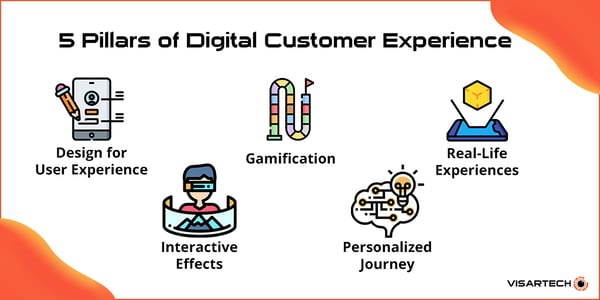
The first thing your users see is design. Without proper design, they’ll simply leave your application. Always listen to your customers – they feel what they need. Ask questions, and interview your existing client base. Try to understand how to offer them what they really need and help them get the relevant information.
But don’t forget - design is not just visual. It's an experience, and a huge part of your storytelling.
There are many things you can improve on your client’s user journey. Users demand more interactivity in their hands - give them that opportunity. Create an interactive application, and make sure your design is as clean as possible. Make everything more dynamic, the society demands it now. The media and features within your application should respond to the user's actions. Update your content and ensure the whole ecosystem is the same and each application and website adds something but doesn’t redirect your customers outside.
A part of user experience is gamification. Now it is a huge trend, probably more than ever. In general, gamification is the application of game mechanics to non-gaming spheres.
As respective sources state, the gamification market worth will grow with a CAGR of 27.4% from $9.1 billion in 2020 to $30.7 billion by 2025.
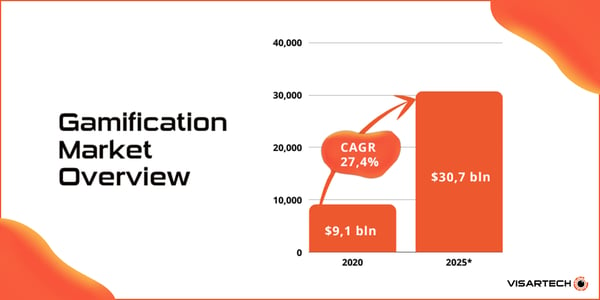
Looks like a good point to add to your ecosystem right now. What drives this growth is the focus on employee engagement and the provision of attractive offers to customers.
Computer games are able to engage players like no other application, so the market simply adopted some of those mechanics into business applications and services by gamifying the last ones. Such techniques are widely implemented in gamified language learning apps and skills mastery applications.
Let's outline a few gamification mechanics:
Probably the most popular gamification use case is Volkswagen. They presented a project that gives an opportunity to design the perfect car for their customers. As a result, they've got 33 million website visits and 119,000 constructed ideas. Gamified mechanics helped the company to significantly increase user coverage, understand consumer's needs, and eventually generate additional revenue.
You should provide your customers with a positive experience while using your product or services, otherwise, they won't buy from you, but go to make purchases from your competitors.
3D technology allows showcasing your products in a variety of ways. This way your customers will actually see what they wish to buy. Besides, the best 3D modeling software helps to create attractive marketing materials making interaction with your products an exciting task for your audience.
3D rendering helps to create beautiful imagery of products. These include product models, 360 product spins, VR demonstrations, 3D room customization, and more.
Besides product rendering, there are other actionable techniques to present products efficiently:
As you can see and feel, 3D gives you a huge advantage over other methods. Our brain is trained to perceive information in 3D.
First people identify signal colors, like red or yellow. Secondly, people identify movement, and only after people start to decipher what they see, they understand the shape and find similarities in their brain.
Without interactive 3D, businesses lose so much user attention on the way. Their brains simply mark that information as invisible, because it has lower priority.
Google is aware of it and has spread the global availability of the so-called Swirl ads. Those are banner ads with interactive 3D product models. Users can interact with a product by rotating, zooming, or expanding it. To get started, all you need is pre-made 3D assets, the rest is handled by the Google tools.
To sum everything mentioned above, don’t forget your customers while showing 3D content. 3D has different mechanics. Make sure it loads fast, your users are able to view it from different angles and can interact with it. And the most valuable thing, your customers must be inside 3D, not outside.
They must be in that scene, in that experience that was designed especially for them. As a result, they will pay you with attention, love, and paychecks.
Surely, 3D is the core element of any digital experience, but there are some tools that help people to see the full-scale effect of 3D. Among such are VR and AR. Let's see how these innovative technologies make the user experience more amazing.
The ability to mix real life with digital life gives a huge potential and numerous cases that have already improved and will improve people's lifestyle even further.
AR technology is still evolving but already has solid hardware and software solutions. Major smartphone manufacturers like Apple and Google have built-in AR as a core feature of their devices. So consumers can leverage its full potential.
As numerous businesses that have already adopted the technology claim, sales are getting increased immensely: 200% higher conversion rates, a 25% drop in product returns are dropping by 25%, and 50% quicker buying decisions.
AR helps retailers to offer consumers trying clothes at a distance and seeing how it looks on them with retail image recognition software. Besides shopping at home through an application, people can easily navigate within the store via directions or indoor maps.
One of the most brilliant cases with AR implementation that already serves the community is IKEA Place. It helps to place the furniture virtual 3D models in the consumer's house, customize its size and color, add it to their cart and finally buy the one of their liking.
Augmented reality actually blends computer-generated reality with the surrounding environment through a smartphone.
Below shows how you can build your own kitchen from available items inside your living space without the need to visit any shops. Capabilities are limitless for AR, and it is a nice example of how digital became real and vise versa. AR helps you to see, try, and feel digital items in real life without the need to obtain those items physically.
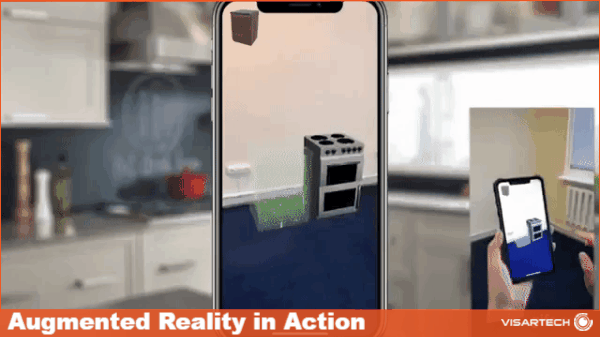
AR is great, but it its limits. We live in a physical space, and AR can only modify it. If you need true freedom for your imagination then virtual reality is the answer. VR is fully digital, but it gives the sensation that all actions take place around a person, with a person,and you feel full immersion into the digital world.
Virtual reality is already popular, but still a young technology. It is extremely hard to fool our brain and dive you fully into digital space. Despite that fact, there are more and more VR applications. It is really popular among computer gamers. Corporations and companies use it for training and simulations.
Now VR uses special headsets that look like goggles. That technique overrides the visual perception of the world and together with sound and vibration effects dive consumers inside the digital experience.
Virtual reality can greatly improve the customer experience and helps overcome various business challenges. It puts your customer into the whole virtual environment.VR can transform shopping experiences in many ways. It not only mimics physical stores, but upgrades them with unreal experiences. As the technology is pretty new, VR installations in stores may attract consumers as a value-add when shopping.
Virtual reality can minimize possible dangers during staff training by simulating real-life situations. VR can transfer users' brains and bodies to another scene. It can teach people, impress, and show new horizons. The only limit is imagination.

A personalized approach helps to predict customer expectations, deliver relevant services quickly, and show how your business is a leader in its niche. The sky's the limit when it comes to the ability to personalize visitor experiences, so start by thinking about what you’d like to accomplish, and then find a way to make it happen.
Every journey relies on something. The major business goal is to make the customer experience as personal and as enjoyable as possible. Personalizations stand on 4 major pillars:
Artificial intelligence is a huge part of personalization. And it is reasonable – only an intelligent system can serve humans as a human.
Among the most prominent examples of personalization is Macy’s On Call. Once a user enters a store, the assistant app communicates with a person by asking questions, giving recommendations, providing directions around the shop and alerting human assistants for personalized consultations.
From five major pillars of digital customer experience, it is clear that users must interact with digital content and that content must interact with a user. Sounds a bit weird, but this is a complicated description of a simple term: communication.
Your business must communicate with your customers and your employees. This is the only way to establish relations that last for years and decades. Impress your users by using mechanics to create interactive 3D applications where users can feel the environment as it is in real life.
You already know the modern approach that forms a better and more customer-oriented experience. Now let’s check out the trends that form that level of interactivity!
Social interactions got automated and robotized. Factories that can work without humans, driverless cars, automatic air conditioners, and more. The world needs a solution to control all of these changes, and the solution is artificial intelligence.
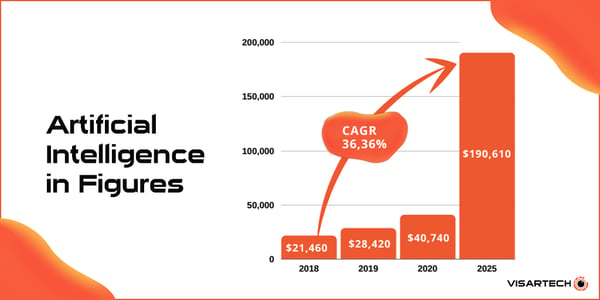
There are simply not enough humans to control all those processes and ordinary things that are crucial to maintaining the human lifestyle. As research suggests, the AI market will be worth $190 billion by 2025.
Companies try to use their big data more efficiently by not only obtaining information about customers from such sources as CRM systems, product reviews, or the Internet of Things, but analyzing them via artificial intelligence. It involves professionals with certain skills in machine learning, sound and image recognition, cognitive learning and deep learning technologies.
AI can greatly predict the production demand and improve operational efficiency in many industries, precisely in manufacturing. Overall, such technologies process much data and help business owners make crucial decisions about the future growth.
Augmented reality is the latest trend that transfers every aspect of our life to a digital space. While other industries and channels adopt digital solutions this one will definitely be the right tool to invest in, an essential element of almost any future system.
Virtual reality is similar to AR but is able to transfer users to a digital space without leaving the houses. The biggest problem with this technology is the lack of high-quality headsets. But even modern headsets can help businesses with many tasks from marketing to high-qualified training.
VR and AR are estimated to be worth almost $600 billion with a CAGR of 64% per the recent research. This is probably the fastest-growing market, which will shape people's lives the most.
The era of standalone applications and systems is gone. Now we think in terms of ecosystems, where data from all possible sources is combined. This is the only way to satisfy your end customers in our highly competitive world.
A well-designed ecosystem is natural and highly stable as it unites all business processes. The most brilliant examples of great ecosystems are built by Google and Apple as they each combine products, software, and hardware. Consumers love both as they have all they need in one place.
This can be easily performed in any type of business. For example, an automotive business may create a configurator, integrate it with a CRM, and synchronize its system with a car manufacturer. It helps to easily navigate between all business departments. It's also convenient to automate all customer-business interactions and make them more efficient.
We live in a fast world, and businesses adopt new technologies in a matter of years. Certain outside circumstances may change the world in a matter of days. With this in mind, businesses should predict and adapt even faster.
The only way to compete in such an environment is to use and understand new approaches and technologies. Innovations only improve people's lives. With an increasing trend toward personalized customer experience and interactive business, it is possible to overwhelm competitors and improve market rankings.
Slava Podmurnyi is the Co-Founder and CEO of Visartech Inc., a software development company that creates experiences via games, 3D models, interactive apps, XR (VR, AR, MR) apps, and custom digital solutions for specific business goals. He dreams to make the world a better place with art and technology.
One of the most evident outcomes of COVID-19 was people going completely remote as an outcome...
.png) by Shreya Mattoo
by Shreya Mattoo
Mixed reality apps (MR) are taking the internet by storm.
 by Jose Bort
by Jose Bort
Let’s go back to move forward.
 by Bridget Poetker
by Bridget Poetker
One of the most evident outcomes of COVID-19 was people going completely remote as an outcome...
.png) by Shreya Mattoo
by Shreya Mattoo
Mixed reality apps (MR) are taking the internet by storm.
 by Jose Bort
by Jose Bort

